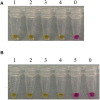Rapid and Visual Identification of Chlorophyllum molybdites With Loop-Mediated Isothermal Amplification Method
- PMID: 33815325
- PMCID: PMC8013719
- DOI: 10.3389/fmicb.2021.638315
Rapid and Visual Identification of Chlorophyllum molybdites With Loop-Mediated Isothermal Amplification Method
Abstract
Chlorophyllum molybdites is a kind of common poisonous mushroom in China that is widely distributed in different areas. Food poisoning caused by accidentally eating C. molybdites has become more frequent in recent years. In 2019, there were 55 food poisoning incidents caused by eating this mushroom in China. Mushroom poisoning continues to be a common health issue of global concern. When mushroom poisoning occurs, an effective, simple, and rapid detection method is required for accurate clinical treatment or forensic analysis. For the first time, we established a loop-mediated isothermal amplification (LAMP) assay for the visual detection of C. molybdites. A set of specific LAMP primers was designed, and the specificity was confirmed against 43 different mushroom species. The LAMP method could detect as low as 1 pg of genomic DNA. Boiled mushrooms and artificial gastric-digested mushroom samples were prepared to test the applicability of the method, and the results showed that as low as 1% C. molybdites in boiled and digested samples could be successfully detected. The LAMP method can also be completed within 45 min, and the reaction results could be directly observed based on a color change under daylight by the naked eye. Therefore, the LAMP assay established in this study provides an accurate, sensitive, rapid, and low-cost method for the detection of C. molybdites.
Keywords: Chlorophyllum molybdites; ITS; loop-mediated isothermal amplification; on-site rapid detection; poisonous mushroom.
Copyright © 2021 Wang, Zhao, Gao, Tian, Yu, Li, Zhang, Xie, Zhao and Chen.
Conflict of interest statement
The authors declare that the research was conducted in the absence of any commercial or financial relationships that could be construed as a potential conflict of interest.
Figures





References
-
- Abubakar B. M., Izham N. H. M., Salleh F. M., Shamsir S., Wagiran A. (2018). Comparison of different DNA extraction methods from leaves and roots of Eurycoma longifolia Plant. Adv. Sci. Lett. 24 3641–3645. 10.1166/asl.2018.11456 - DOI
-
- Ahmed W. H. A., Gonmori K., Suzuki M., Watanabe K., Suzuki O. (2010). Simultaneous analysis of α-amanitin, β-amanitin, and phalloidin in toxic mushrooms by liquid chromatography coupled to time-of-flight mass spectrometry. Forensic. Toxicol. 28 69–76. 10.1007/s11419-009-0089-7 - DOI
-
- Becherer L., Borst N., Bakheit M., Frischmann S., Stetten F. V. (2020). Loop-mediated isothermal amplification (LAMP) – review and classification of methods for sequence-specific detection. Anal. Methods 12 717–746. 10.1039/C9AY02246E - DOI
LinkOut - more resources
Full Text Sources
Other Literature Sources

